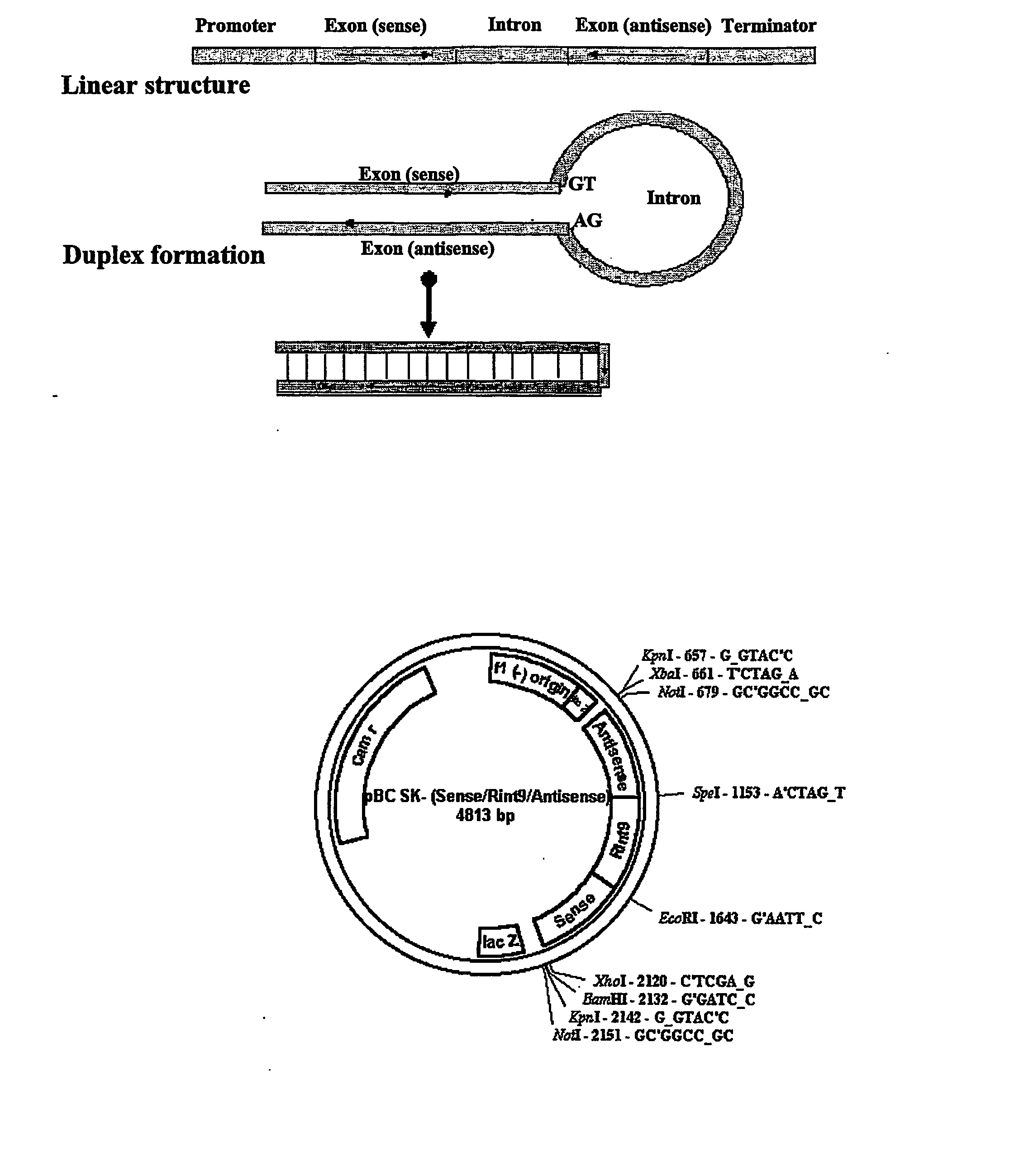Rice and Products Thereof Having Starch With an Increased Proportion of Amylose
a technology of amylose and rice, which is applied in the field of rice, can solve the problems of affecting the expression of sbeiia, the processing has a tendency to either alter other components of value, or carry the perception of being undesirable, and achieves the effects of inhibiting sbeiia expression, reducing the activity or level of sbeiia, and reducing the expression of sbeiib
- Summary
- Abstract
- Description
- Claims
- Application Information
AI Technical Summary
Benefits of technology
Problems solved by technology
Method used
Image
Examples
example 1
Materials and Methods
Materials and Media
[0128] N6 macro-elements (20× stock solution)
g / l(NH4)2SO49.3KNO356.6KH2PO48MgSO4•7H2O3.7CaCl2•2H2O3.3
[0129] MS Macro-Elements (20× Stock Solution)
g / lNH4NO333.0KNO338.0KH2PO43.4MgSO4•7H2O7.4CaCl2•2H2O8.8
[0130] N6 Micro-Elements (1000× Stock Solution)
mg / 100 mlMnSO4•4H2O440ZnSO4•7H2O150H3BO3160KI80
[0131] MS Micro-Elements (1000× Stock Solution)
mg / lMnSO4•4H2O22300Na2MoO4•2H2O250H3BO36220ZnSO4•7H2O8600CuSO4•5H2O25CoCl2•6H2O25KI830
[0132] B5 Micro-Elements (100× Stock Solution)
mg / lMnSO4•4H2O1000Na2MoO4•2H2O25H3BO3300ZnSO4•7H2O200CuSO4•5H2O3.87CoCl2•6H2O2.5KI75
[0133] N6 Vitamins (100× Stock Solution)
mg / 100 mlGlycine20Thiamine-HCl10Pyridoxine-HCl5Nicotinic acid5
[0134] MS Vitamins (100× Stock Solution)
mg / 100 mlmyo-Inositol1000Thiamine-HCl1Pyridoxine-HCl5Nicotinic acid5
[0135] B5 Vitamins (100× Stock Solution)
mg / 100 mlGlycine1000Thiamine-HCl100Pyridoxine-HCl10Nicotinic acid10
[0136] MS Na2.EDTA(200× Stock Solution)
g / 500 mlNa2.•EDTA3.7
[...
example 2
Construct Preparation for Gene Down-Regulation
[0156] Segments of the rice SBEI, SBEIIa and SBEIIb genes were applied by PCR for use in preparation of gene constructs for the down-regulation of gene expression in rice. The segments chosen were from exon regions near the 3′ ends of the genes as these regions of the genes are more divergent and this was thought to reduce the likelihood of cross-silencing of the genes by the constructs in transformed rice. The segments amplified were: SBEI-nucleotides 1982-2527 of GenBank accession No. D11082; SBEIIa-nucleotides 2458-2997 of Accession No. AB023498; SBEIIb-nucleotides 2414 to 2912 of Accession No. D16201 (Sequences shown in FIGS. 1-3). The amplified fragments, which contained additional sequences comprising restriction endonuclease sites at the ends for convenience in subsequent cloning steps, were cloned into the plasmid vector pGEM®-T. An intron sequence was also obtained by amplifying the SBEI intron 9 sequence from rice. The fragmen...
example 3
Production of Rice with Reduced SBE Activity
[0160] The constructs dsSBEI, dsSBEIIa, dsSBEIIb and ds-wSBEIIa in AGL1 cells were used to produce transformed rice plants (cv. Nipponbare) according to the methods described in Example 1. Five hundred rice calli were used for each construct, transformed calli selected and rice plants regenerated. After the plants were transferred to soil, transformation of the plants was demonstrated by PCR or Southern blot hybridization analysis using primers or probes specific for the SBEI, SBEIIa or SBEIIb gene segments used. Of 24 regenerated plants from the transformation with ds-wSBEIIa, 21 were shown to be positive for the introduced SBEIIa sequences.
[0161] Grain from the transformed plants (T1 seed) is assayed for SBE proteins by Western blot analysis using specific antibodies to the respective proteins, after gel electrophoresis of endosperm proteins on acrylamide gels. SBE activity is reduced in the majority of transformed lines. The proportio...
PUM
| Property | Measurement | Unit |
|---|---|---|
| weight | aaaaa | aaaaa |
| grain size | aaaaa | aaaaa |
| size | aaaaa | aaaaa |
Abstract
Description
Claims
Application Information
 Login to View More
Login to View More - R&D
- Intellectual Property
- Life Sciences
- Materials
- Tech Scout
- Unparalleled Data Quality
- Higher Quality Content
- 60% Fewer Hallucinations
Browse by: Latest US Patents, China's latest patents, Technical Efficacy Thesaurus, Application Domain, Technology Topic, Popular Technical Reports.
© 2025 PatSnap. All rights reserved.Legal|Privacy policy|Modern Slavery Act Transparency Statement|Sitemap|About US| Contact US: help@patsnap.com



